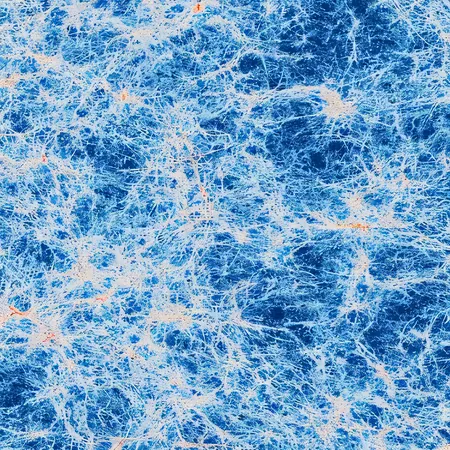
Astronomers Unveil First Direct Image of the Universe's Enigmatic "Cosmic Web"
2025-06-30
Author: Ming
Space is teeming with hidden wonders! Far from being just a void, the cosmos is intricately woven with nearly invisible strands of matter, known as the "cosmic web." This vast network serves as the invisible architecture that binds galaxies and guides their evolution.
For a long time, the delicate filaments of this web existed only in theoretical models and educated guesses. However, a groundbreaking new observation has brought one of these elusive strands into the spotlight.
A Historic Discovery Amidst Distant Quasars
The revelation emerged from a region of the sky illuminated by two ancient quasars, shining over 11 billion light-years away. The intense brightness of these quasars backlit a faint hydrogen bridge connecting them.
Capturing this filament was no small feat—it took hundreds of hours of telescope time and specialized instruments designed for meticulous astronomical observations.
Illuminating the Cosmic Web
In this ambitious project, an international team led by the University of Milano-Bicocca collaborated with the Max Planck Institute for Astrophysics to examine the twin quasars closely. Remarkably, both galaxies hide voracious black holes and date back to a time when the universe was only about 2 billion years old.
They successfully traced the slender strand of hydrogen linking these galaxies across an astonishing 3 million light-years.
Advanced Tools at Work
Using the cutting-edge Multi-Unit Spectroscopic Explorer (MUSE) on the European Southern Observatory’s Very Large Telescope (VLT) in Chile, astronomers were able to gather precise data. MUSE distinguishes the filament’s faint hydrogen emissions from surrounding noise, shedding new light on cosmic structures.
Unveiling the Universe's Secrets
This direct observation provides insight into the early universe, revealing a gas flow along a gravitational highway towards the galaxies’ outskirts. This material is the fundamental building block for future stars.
It validates a vital idea from cold dark matter theories: galaxies grow by drawing in gas via web-like structures rather than consuming isolated clouds. Cold dark matter also suggests that about 85% of the universe's mass remains hidden from conventional telescopes.
A New Perspective on Cosmic Matter
The discovered filament offers a fresh perspective on this unseen mass, as its luminance correlates with the surrounding dark matter density. By aligning real observations with theoretical models, scientists can better estimate how much ordinary gas dark matter captures.
Pioneering Precision with MUSE
Davide Tornotti, a Ph.D. student at the University of Milano-Bicocca and the study's lead, expressed excitement about the precision achieved: “By capturing the faint light emitted by this filament, which traveled nearly 12 billion years to reach Earth, we can accurately delineate its shape.”
This unprecedented clarity allows astronomers to differentiate the gas occupying galaxies from that within the cosmic web.
From Virtual Models to Reality
Simulations performed at the Max Planck Institute treated gravity as the architect of dark matter. The ordinary gas settled along this scaffold like morning mist in valleys. When researchers juxtaposed the synthetic filament against the observed one, the results were astonishingly congruent.
The illuminating match serves as a reality check for alternative theories regarding dark matter.
Filaments: The Architects of Galaxies
Flowing gas doesn’t just form stars; it also influences a galaxy’s structure, supplying fresh hydrogen to their disks and enhancing their spiral arms. Without a steady inflow, galaxies would deplete their gas reserves in mere hundreds of millions of years.
This new image reinforces the idea that gas inflow occurs early and on an expansive scale, highlighting a clear demarcation where intergalactic gas transitions into material captured by galaxies.
The Journey Ahead for Cosmic Exploration
Excitingly, Fabrizio Arrigoni Battaia, a scientist involved in the study, emphasized, “While we celebrate this achievement, we know that one observation isn’t enough. We are committed to uncovering more such structures and ultimately mapping the gas distribution across the cosmic web.”
Future experiments with next-gen instruments, like the Extremely Large Telescope’s high-resolution spectrographs, promise to reveal even more filaments, gradually constructing a detailed atlas of the universe’s scaffolding.
Each newly identified strand will further refine our understanding of dark matter and galaxy evolution, refining our cosmic narrative.
For now, the image of this filament connecting two blazing quasars stands as the most detailed snapshot of the web holding our universe together. It illustrates gas flowing along a delicate highway, nourishing galaxies in their infancy. This observation demonstrates how patient inquiry can illuminate structures once considered beyond reach, and as astronomers uncover more strands, the intricate tapestry of our universe will come into clearer focus.

 Brasil (PT)
Brasil (PT)
 Canada (EN)
Canada (EN)
 Chile (ES)
Chile (ES)
 Česko (CS)
Česko (CS)
 대한민국 (KO)
대한민국 (KO)
 España (ES)
España (ES)
 France (FR)
France (FR)
 Hong Kong (EN)
Hong Kong (EN)
 Italia (IT)
Italia (IT)
 日本 (JA)
日本 (JA)
 Magyarország (HU)
Magyarország (HU)
 Norge (NO)
Norge (NO)
 Polska (PL)
Polska (PL)
 Schweiz (DE)
Schweiz (DE)
 Singapore (EN)
Singapore (EN)
 Sverige (SV)
Sverige (SV)
 Suomi (FI)
Suomi (FI)
 Türkiye (TR)
Türkiye (TR)
 الإمارات العربية المتحدة (AR)
الإمارات العربية المتحدة (AR)